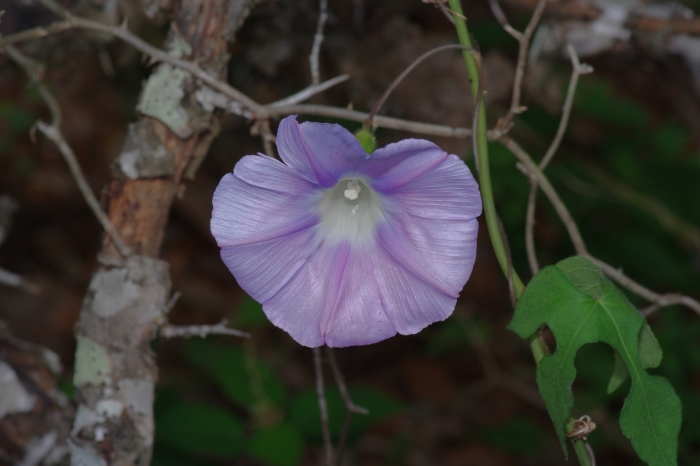Lindheimer’s Morning Glory
(Ipomoea lindheimeri)
Lindheimer’s Morning Glory (Ipomoea lindheimeri)
/
/

Michelle W.
CC BY 4.0
Image By:
Michelle W.
Recorded By:
Copyright:
CC BY 4.0
Copyright Notice:
Photo by: Michelle W. | License Type: CC BY 4.0 | License URL: http://creativecommons.org/licenses/by/4.0/ | Rights Holder: Michelle W. | Publisher: iNaturalist | Date Created: 2021-05-30T11:48:17-07:00 |

























Estimated Native Range
Summary
Ipomoea lindheimeri, commonly known as Lindheimer’s morning glory, is a perennial climbing vine native to open woodlands and prairies of the southwestern United States, particularly Texas. It is a vigorous grower, reaching lengths of up to 10 feet (3 meters) in a single season. The vine is adorned with heart-shaped leaves and large, funnel-shaped flowers that are typically blue to purple, blooming profusely from early summer to fall. The flowers are notably showy, opening in the morning and closing by afternoon, attracting pollinators such as bees and hummingbirds.
Lindheimer’s morning glory is valued for its rapid growth and the vibrant splash of color it provides. It is often used to cover trellises, fences, and arbors, creating a natural screen or vertical accent in the garden. This plant is relatively low-maintenance, requiring minimal care once established. It prefers full sun exposure and well-drained soils, although it can tolerate a range of soil types. Regular watering will support its vigorous growth, but it can also withstand short periods of drought. While generally disease-free, it can occasionally suffer from pests such as aphids and spider mites. Gardeners should be aware that in some areas, it can become invasive if not managed properly.CC BY-SA 4.0
Lindheimer’s morning glory is valued for its rapid growth and the vibrant splash of color it provides. It is often used to cover trellises, fences, and arbors, creating a natural screen or vertical accent in the garden. This plant is relatively low-maintenance, requiring minimal care once established. It prefers full sun exposure and well-drained soils, although it can tolerate a range of soil types. Regular watering will support its vigorous growth, but it can also withstand short periods of drought. While generally disease-free, it can occasionally suffer from pests such as aphids and spider mites. Gardeners should be aware that in some areas, it can become invasive if not managed properly.CC BY-SA 4.0
Plant Description
- Plant Type: Herb, Vine
- Height: 1-3 feet
- Width: 1-2 feet
- Growth Rate: Rapid
- Flower Color: Blue, Purple
- Flowering Season: Spring, Summer, Fall
- Leaf Retention: Semi-deciduous
Growth Requirements
- Sun: Full Sun
- Water: Medium
- Drainage: Medium
Common Uses
Border Plant, Butterfly Garden, Low Maintenance, Showy Flowers
Natural Habitat
Open woodlands and prairies of the southwestern United States, particularly Texas
Other Names
Common Names: Texas bindweed, Blue morning glory
Scientific Names: , Ipomoea lindheimeri, Ipomoea heterophylla, Ipomoea heterophylla var. aemula, Pharbitis lindheimeri,
GBIF Accepted Name: